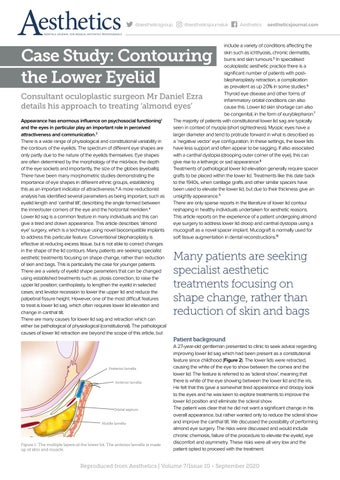@aestheticsgroup
@aestheticsjournaluk
Aesthetics
aestheticsjournal.com
include a variety of conditions affecting the skin such as ichthyosis, chronic dermatitis, burns and skin tumours.5 In specialised oculoplastic aesthetic practice there is a significant number of patients with postblepharoplasty retraction, a complication as prevalent as up 20% in some studies.6 Thyroid eye disease and other forms of Consultant oculoplastic surgeon Mr Daniel Ezra inflammatory orbital conditions can also details his approach to treating ‘almond eyes’ cause this. Lower lid skin shortage can also be congenital, in the form of euryblepharon.7 1 Appearance has enormous influence on psychosocial functioning The majority of patients with constitutional lower lid sag are typically and the eyes in particular play an important role in perceived seen in context of myopia (short sightedness). Myopic eyes have a attractiveness and communication.2 larger diameter and tend to protrude forward in what is described as There is a wide range of physiological and constitutional variability in a ‘negative vector’ eye configuration. In these settings, the lower lids the contours of the eyelids. The spectrum of different eye shapes are have less support and often appear to be sagging. If also associated only partly due to the nature of the eyelids themselves. Eye shapes with a canthal dystopia (drooping outer corner of the eye), this can are often determined by the morphology of the mid-face, the depth give rise to a lethargic or sad appearance.8 of the eye sockets and importantly, the size of the globes (eyeballs). Treatments of pathological lower lid elevation generally require spacer There have been many morphometric studies demonstrating the grafts to be placed within the lower lid. Treatments like this date back importance of eye shapes in different ethnic groups, establishing to the 1940s, when cartilage grafts and other similar spacers have this as an important indicator of attractiveness.3 A more reductionist been used to elevate the lower lid, but due to their thickness give an analysis has identified several parameters as being important, such as unsightly appearance.9 eyelid length and ‘canthal tilt’, describing the angle formed between There are only sparse reports in the literature of lower lid contour the inner/outer corners of the eye and the horizontal meridien.4 reshaping in healthy individuals undertaken for aesthetic reasons. Lower lid sag is a common feature in many individuals and this can This article reports on the experience of a patient undergoing almond give a tired and drawn appearance. This article describes ‘almond eye surgery to address lower lid droop and canthal dystopia using a eye’ surgery, which is a technique using novel biocompatible implants mucograft as a novel spacer implant. Mucograft is normally used for to address this particular feature. Conventional blepharoplasty is soft tissue augmentation in dental reconstructions.10 effective at reducing excess tissue, but is not able to correct changes in the shape of the lid contours. Many patients are seeking specialist aesthetic treatments focusing on shape change, rather than reduction of skin and bags. This is particularly the case for younger patients. There are a variety of eyelid shape parameters that can be changed using established treatments such as: ptosis correction, to raise the upper lid position; canthoplasty, to lengthen the eyelid in selected cases; and levator recession to lower the upper lid and reduce the palpebral fissure height. However, one of the most difficult features to treat is lower lid sag, which often requires lower lid elevation and change in canthal tilt. There are many causes for lower lid sag and retraction which can either be pathological of physiological (constitutional). The pathological causes of lower lid retraction are beyond the scope of this article, but
Case Study: Contouring the Lower Eyelid
Many patients are seeking specialist aesthetic treatments focusing on shape change, rather than reduction of skin and bags Patient background
Posterior lamella
Anterior lamella
Orbital septum
Middle lamella
Figure 1: The multiple layers of the lower lid. The anterior lamella is made up of skin and muscle.
A 27-year-old gentleman presented to clinic to seek advice regarding improving lower lid sag which had been present as a constitutional feature since childhood (Figure 2). The lower lids were retracted, causing the white of the eye to show between the cornea and the lower lid. The feature is referred to as ‘scleral show’, meaning that there is white of the eye showing between the lower lid and the iris. He felt that this gave a somewhat tired appearance and droopy look to the eyes and he was keen to explore treatments to improve the lower lid position and eliminate the scleral show. The patient was clear that he did not want a significant change in his overall appearance, but rather wanted only to reduce the scleral show and improve the canthal tilt. We discussed the possibility of performing almond eye surgery. The risks were discussed and would include chronic chemosis, failure of the procedure to elevate the eyelid, eye discomfort and asymmetry. These risks were all very low and the patient opted to proceed with the treatment.
Reproduced from Aesthetics | Volume 7/Issue 10 - September 2020














